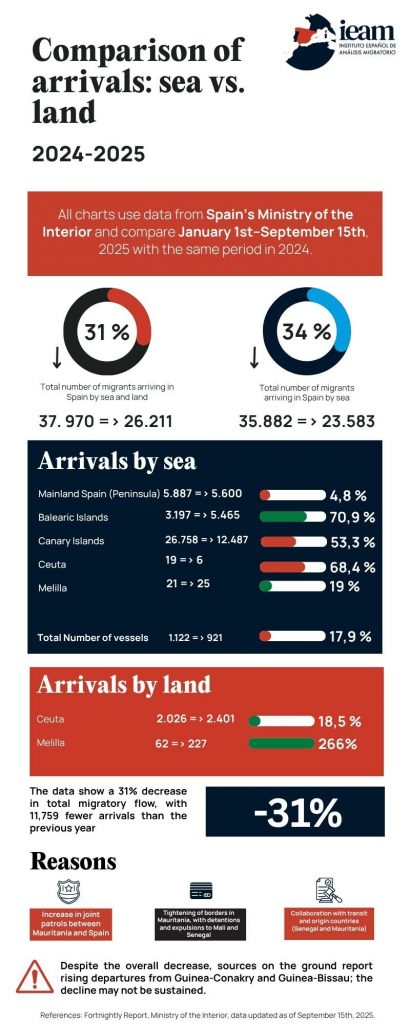According to the latest data published by Spain’s Ministry of the Interior, migratory flows towards Spain have fallen by 31% between January 1 and September 15, 2025, compared to the same period in 2024. In total, 26,211 people arrived in Spain, down from 37,970 the previous year.
Overall decline, but regional contrasts
The report shows that sea arrivals have dropped by 34%, from 35,882 to 23,583 people. The Canary Islands, traditionally a main entry point from West Africa, account for most of this decrease: from 26,758 in 2024 to 12,487 in 2025 — a 53.3% reduction. Ceuta also records a steep decline (-68.4%), while Melilla sees a slight increase (+19%).
Conversely, the Balearic Islands show a sharp 70.9% increase, suggesting a partial shift of migration routes towards the central Mediterranean. The total number of intercepted vessels has also fallen by 17.9%, from 1,122 to 921.
Regarding land arrivals, the trend is reversed: Ceuta records an 18.5% increase (from 2,026 to 2,401 people) and Melilla a 266% rise (from 62 to 227), indicating renewed migratory pressure at Spain’s land borders, particularly in Melilla.
Factors explaining the decline
The main factors identified include:
- Strengthened joint patrols between Mauritania and Spain, improving maritime surveillance.
- Tighter border controls in Mauritania and increased detentions and expulsions to Mali and Senegal.
- Enhanced cooperation with transit and origin countries, such as Senegal and Mauritania.
Despite the overall decline, departures from Guinea Conakry and Guinea-Bissau have increased, according to field sources. This suggests that the current drop might be temporary and that migration flows could rise again if conditions in origin countries do not improve.
Conclusion
The provisional 2025 balance points to a downward trend in migration to Spain, driven by the decrease in sea arrivals. However, migratory pressure remains, and routes continue to adapt to changing control measures and international cooperation. Continuous monitoring of these dynamics will be essential to anticipate future movements and design effective, sustainable migration policies.


